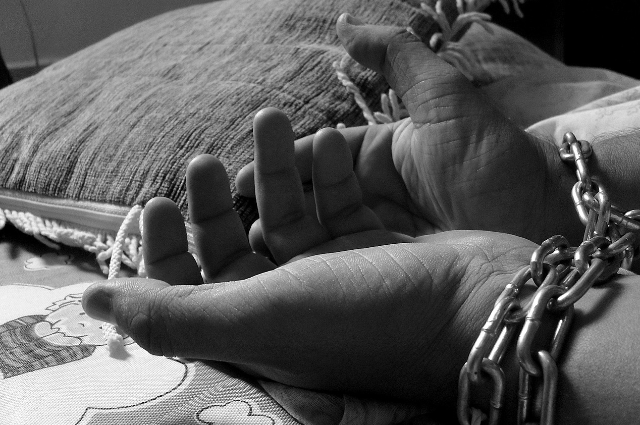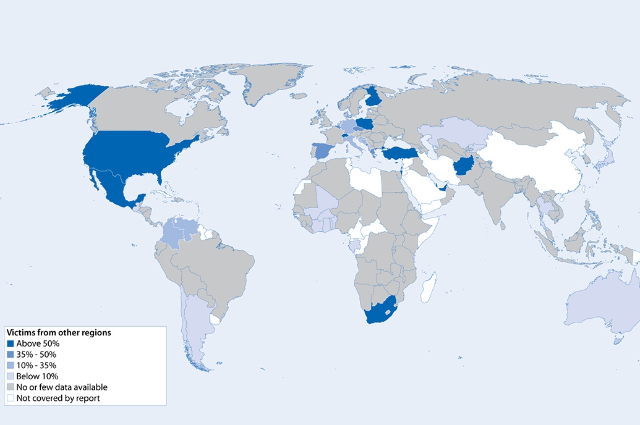
Image by Sammis Reachers from Pixabay
Introduction
Women trafficking and kidnapping represent severe human rights violations that impact millions of lives globally. This article delves into the magnitude of the crisis, providing a fact-based examination of its prevalence, causes, consequences, and the measures being undertaken to combat it. The focus will be on delivering an in-depth analysis supported by data, expert opinions, and case studies to underline the urgency of addressing these issues effectively.
Prevalence of Women Trafficking
Human trafficking, particularly of women and girls, is a pervasive issue worldwide. According to the United Nations Office on Drugs and Crime (UNODC), approximately 71% of trafficking victims globally are women and girls, with the majority being trafficked for sexual exploitation. In 2020, the International Labour Organization (ILO) estimated that 4.8 million people were victims of forced sexual exploitation, 99% of whom were women and girls.
Regional Distribution
The issue manifests differently across regions. In Asia, for example, trafficking for labour exploitation is more common, while in Europe and North America, sexual exploitation is predominant. Africa sees a mix of both, compounded by conflicts that exacerbate vulnerabilities.
- Asia: The Mekong region, including countries like Cambodia, Laos, Myanmar, Thailand, and Vietnam, is a hotspot for trafficking. The Global Slavery Index reports that India, China, and Pakistan have the highest number of trafficking victims in the region.
- Europe: The European Commission highlights that Eastern European countries are major source regions for trafficking victims, with many being transported to Western Europe.
- Africa: Conflict zones in Nigeria, the Democratic Republic of Congo, and Somalia see high incidences of women being trafficked for both sexual and labour exploitation.
- Americas: In Latin America, particularly in countries like Brazil, Mexico, and Venezuela, women are often trafficked internally and externally for prostitution and forced labour.
Causes of Women Trafficking
The root causes of women trafficking are multifaceted, involving economic, social, political, and cultural factors. Understanding these causes is crucial for developing effective prevention strategies.
- Economic Factors: Poverty is a significant driver, pushing women and girls into vulnerable situations where they become easy targets for traffickers. In many cases, promises of employment and a better life lure them into trafficking networks.
- Social Factors: Gender inequality, lack of education, and social exclusion contribute to women's vulnerability. In many societies, women have limited opportunities for legitimate employment, making them more susceptible to traffickers' deceptive offers.
- Political Instability and Conflict: War and conflict displace large populations, creating chaos and lawlessness that traffickers exploit. Refugee camps and conflict zones often become recruitment grounds for traffickers.
- Corruption: Corruption within law enforcement and border control agencies facilitates trafficking. Bribes and collusion with traffickers allow them to operate with impunity.
- Cultural Practices: In some regions, traditional practices like child marriage and dowry systems contribute to trafficking. Girls are sold or forced into marriages that result in exploitation.
Impact on Victims
The consequences of trafficking on victims are devastating and long-lasting, affecting their physical, psychological, and social well-being.
- Physical Health: Trafficking victims often endure physical abuse, sexual violence, and inhumane living conditions. Many suffer from sexually transmitted infections (STIs), unwanted pregnancies, and chronic health issues.
- Psychological Trauma: The psychological impact includes severe trauma, depression, anxiety, and post-traumatic stress disorder (PTSD). The coercion, manipulation, and violence they experience leave deep emotional scars.
- Social Isolation: Victims are often isolated from their families and communities, which exacerbates their trauma. The stigma associated with trafficking and exploitation further alienates them from society.
- Economic Deprivation: Trafficking strips victims of their autonomy and economic opportunities. They are often forced into debt bondage, with their earnings going to traffickers.
Kidnapping and Its Role in Trafficking
Kidnapping is a common method traffickers use to acquire victims. This section examines the link between kidnapping and trafficking, highlighting specific tactics used by traffickers.
Kidnapping Techniques
- Abduction: Victims are forcibly taken from their homes, schools, or workplaces. Abduction often involves physical violence and threats. For example, in rural India, reports of girls being snatched from their villages by traffickers are alarmingly frequent.
- Deception: Traffickers lure victims with false promises of jobs, education, or marriage. Once isolated, victims are held against their will. In Eastern Europe, many women have been deceived by offers of lucrative jobs abroad, only to find themselves trapped in brothels.
- Online Grooming: The rise of the internet has given traffickers new tools to groom and kidnap victims. Social media platforms are often used to build trust and manipulate victims into meeting in person. Cases from the United States show young girls being groomed by traffickers posing as friends or romantic interests online.
- Drugging and Abduction: In many cases, traffickers use drugs to incapacitate their victims before abducting them. This method has been widely reported in nightlife settings, where women are drugged in bars or clubs.
- False Relationships: Traffickers often establish romantic relationships with their victims, earning their trust before manipulating and coercing them into trafficking. This method, known as "lover-boy" or "Romeo pimping," is common in Western Europe.
Case Studies
- Nigeria’s Chibok Girls: In 2014, Boko Haram kidnapped 276 schoolgirls from Chibok, Nigeria. Many were forced into marriage with militants, while others were trafficked across borders. The international #BringBackOurGirls campaign highlighted the plight of these girls, though many remain missing.
- Eastern Europe: In Moldova, Ukraine, and Romania, women are often kidnapped and trafficked to Western Europe. Organized crime networks play a significant role in these kidnappings. For instance, the "Harrowing Escape" case in 2015 involved 18 Romanian women rescued from a trafficking ring in the UK, where they were forced into prostitution.
- India’s Missing Children: Every year, thousands of children, especially girls, go missing in India. Many are kidnapped for trafficking into forced labour and sexual exploitation. The case of Nithari in 2006, where the remains of several missing children were found, highlighted the horrors of trafficking in India.
- Mexico’s Femicide Crisis: In Mexico, rampant kidnapping and trafficking are part of the broader femicide crisis. The case of the "Las Muertas de Juárez," where hundreds of women were kidnapped and murdered in Ciudad Juárez, brought international attention to the issue.
- The United States: The case of Jaycee Lee Dugard, who was kidnapped at age 11 and held captive for 18 years, exemplifies the long-term trauma and exploitation that kidnapping victims can endure. Her captor, Phillip Garrido, used both physical and psychological coercion to control her.
Global Efforts to Combat Trafficking and Kidnapping
Efforts to combat trafficking and kidnapping involve international cooperation, national policies, and grassroots initiatives. This section outlines key measures and their effectiveness.
International Legal Frameworks
- The Palermo Protocol: Adopted by the UN in 2000, this protocol aims to prevent, suppress, and punish trafficking, particularly of women and children. It provides a comprehensive legal framework for countries to enhance their anti-trafficking efforts.
- ILO Conventions: The ILO’s Forced Labour Convention (No. 29) and the Worst Forms of Child Labour Convention (No. 182) set standards to eliminate forced labour and trafficking.
National Policies
- United States: The Trafficking Victims Protection Act (TVPA) of 2000 establishes measures to prevent trafficking, protect victims, and prosecute traffickers. The annual Trafficking in Persons (TIP) Report ranks countries based on their anti-trafficking efforts.
- European Union: The EU has implemented a Directive on preventing and combating trafficking in human beings and protecting its victims, which mandates member states to adopt stringent anti-trafficking measures.
- India: The Immoral Traffic (Prevention) Act (ITPA) and the National Anti-Trafficking Bill provide legal frameworks for combating trafficking. However, enforcement remains a challenge.
Grassroots Initiatives
- Survivor Networks: Organizations like Girls Not Brides and Apne Aap work with survivors to provide support and advocate for policy changes.
- Community Vigilance: In many regions, local communities play a critical role in identifying and preventing trafficking. Community-based programs educate and empower residents to report suspicious activities.
- Technology Solutions: NGOs and tech companies are developing apps and online platforms to help victims report trafficking and access resources.
Challenges and Barriers
Despite numerous efforts, several challenges hinder the fight against trafficking and kidnapping.
- Lack of Resources: Many countries, especially in the Global South, lack the financial and human resources to effectively combat trafficking.
- Weak Law Enforcement: Corruption, inadequate training, and lack of coordination among law enforcement agencies impede anti-trafficking efforts.
- Victim Identification: Identifying victims is challenging due to their hidden nature and fear of reprisals. Many victims do not come forward due to distrust of authorities.
- Legal and Policy Gaps: Inconsistent legal frameworks and policies across countries create loopholes that traffickers exploit. International cooperation is often hampered by differing legal standards.
Additional Case Studies
To underscore the human impact and the complexity of trafficking and kidnapping, we present more real-life case studies from various parts of the world.
- The Natasha Kampusch Case (Austria): Natasha Kampusch was kidnapped at age 10 in 1998 by Wolfgang Priklopil and held captive for eight years. Her abduction and eventual escape in 2006 shed light on the horrors of long-term captivity and the psychological manipulation used by kidnappers.
- The Cleveland Abductions (USA): In a highly publicized case, Ariel Castro kidnapped Michelle Knight, Amanda Berry, and Gina DeJesus in Cleveland, Ohio, between 2002 and 2004. They were held captive for nearly a decade before Berry's escape led to their rescue in 2013. The case highlighted the resilience of the victims and the importance of community vigilance.
- Cambodia's Trafficking Crisis: In Cambodia, women and girls are frequently trafficked to neighbouring countries like Thailand and Malaysia for forced labour and sexual exploitation. The case of Somaly Mam, a survivor who became an activist, brought international attention to the plight of trafficking victims in Southeast Asia and the need for robust cross-border anti-trafficking measures.
- Rohingya Women and Girls (Myanmar/Bangladesh): The Rohingya crisis has led to widespread trafficking of women and girls from refugee camps in Bangladesh. Traffickers exploit their desperate situations, promising safety and employment, only to trap them in forced labour or sexual exploitation. International NGOs have been working tirelessly to address these human rights abuses.
- The Yazidi Women (Iraq/Syria): During the rise of ISIS, thousands of Yazidi women and girls were kidnapped, sold, and sexually enslaved. The rescue and rehabilitation efforts for these survivors have been complex, involving international organizations and local communities working together to provide support and seek justice.
Conclusion
Women trafficking and kidnapping are grave violations of human rights that demand urgent and concerted action. By understanding the complexities of these issues and implementing comprehensive, multi-faceted strategies, we can make significant strides in combating these heinous crimes. The fight against trafficking and kidnapping requires global solidarity, unwavering commitment, and a collective resolve to protect the dignity and rights of every individual.
In the words of former UN Secretary-General Ban Ki-moon, "Let us remember that human trafficking is not just a crime; it is a dehumanizing assault on the rights and dignity of individuals. Together, we must end this modern-day slavery and restore freedom and justice to its victims." By addressing the root causes, enhancing legal frameworks, supporting survivors, and fostering international cooperation, we can move closer to a world where trafficking and kidnapping are consigned to history.
Social Message
The fight against women trafficking and kidnapping is not just a governmental or organizational responsibility; it is a moral imperative for every individual. We must collectively raise our voices against these atrocities and advocate for a world where women and girls can live free from fear and exploitation. By educating ourselves and our communities, supporting victim-centred approaches, and demanding accountability, we can create a safer, more just society for all.

